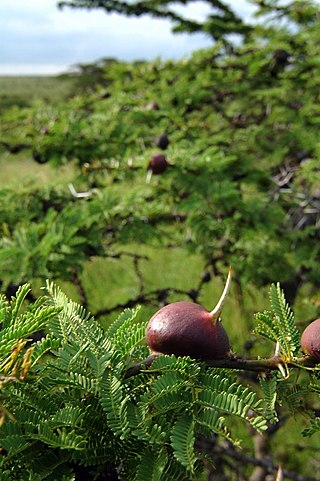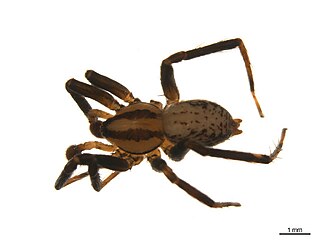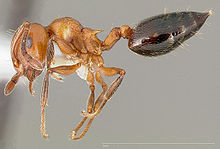
Crematogaster is an ecologically diverse genus of ants found worldwide, which are characterised by a distinctive heart-shaped gaster (abdomen), which gives them one of their common names, the Saint Valentine ant. Members of this genus are also known as cocktail ants because of their habit of raising their abdomens when alarmed. Most species are arboreal (tree-dwelling). These ants are sometimes known as acrobat ants.

Vachellia drepanolobium, more commonly known as Acacia drepanolobium or whistling thorn, is a swollen-thorn acacia native to East Africa. The whistling thorn grows up to 6 meters tall. It produces a pair of straight spines at each node, some of which have large bulbous bases. These swollen spines are naturally hollow and occupied by any one of several symbiotic ant species. The common name of the plant is derived from the observation that when wind blows over bulbous spines in which ants have made entry and exit holes, they produce a whistling noise.

Crematogaster ashmeadi, commonly known as the acrobat ant, is an arboreal ant widespread in the Southeastern United States. It nests and forages almost exclusively above ground level, often found in treetops and on lianas. It is one of eleven species in the genus Crematogaster that is native to eastern North America. This ant species has been observed to raid wasp nests, including the species Mischocyttarus mexicanus, and to forage on their brood. It is the most dominant arboreal ant in the pine forests of the coastal plains of northern Florida. Colonies of these ants inhabit a majority of pine trees in the area, living in chambers in the outer bark of living trees that have been abandoned by bark-mining caterpillars, usually of the family Cossidae. C. ashmeadi does little to no excavation of its own, relying solely on chambers bored out by other insects.
Myrmarachne melanotarsa, the dark-footed ant-spider, is an African jumping spider found around Lake Victoria in Africa. Like other spiders in the genus Myrmarachne, these spiders mimic ants, in this case, ants of the genus Crematogaster. However, they are unusual in that they exhibit some form of social behavior, forming clusters of silk nests on fig and other trees. Hundreds of these spiders, of both sexes and of all ages, can be found in such communal nests, but most nests have between 10 and 50 spiders. The Crematogaster ants which they mimic are often found in the nests with the spiders, along with other species of jumping spider.
Crematogaster elegans is a species of ant in the genus Crematogaster.

Crematogaster peringueyi is a southern African arboreal species of ant. They are commonly known as the black cocktail ant or swartwipgatmier (Afrikaans) for their colour and habit of arching their abdomens when alarmed.
Crematogaster australis is a species of ant in tribe Crematogastrini. It was described by Mayr in 1876. The species is native to Australia, as the name australis suggests.
Crematogaster buddhae is a species of ant in tribe Crematogastrini. It was described by Forel in 1902. It is found across South and South-East Asia.

Crematogaster carinata is a species of ant in the tribe Crematogastrini. It was first described by Gustav Mayr in 1862. It is native to Central and South America, where it is a common species, forming large colonies in the canopy of the forest.

Crematogaster lineolata is a species of ant in the family Formicidae.

Zora hespera is a species of prowling spider in the family Miturgidae. It is found in the United States and Canada.

Crematogaster torosa is a species of ant in the family Formicidae.

Crematogaster emeryana is a species of ant in the family Formicidae.

Crematogaster laeviuscula, known generally as the acrobat ant or valentine ant, is a species of ant in the family Formicidae.

Crematogaster mutans is a species of ant in the family Formicidae.

Crematogaster marioni is a species of ant in the family Formicidae.
Crematogaster punctulata is a species of ant in the family Formicidae.
Tetraponera penzigi, is a species of ant of the subfamily Pseudomyrmecinae, which can be found in East Africa. It forms an obligate symbiosis with the whistling thorn acacia, a dominant tree in some upland areas of East Africa.

Holorusia hespera, the giant western crane fly, is a species of crane fly in the family Tipulidae. It is found in western North America.

Crematogaster aurora is a valid species of myrmicine ant that lived in Baltic Europe about 46 million to 43 million years ago during the Cenozoic era Eocene epoch. C. aurora has a similar look to the ant genus Acanthomyrmex and shares some similarities with the ant genus Pristomyrmex. The fossil found of C. aurora is of a queen ant that is brown in coloration. It probably died by drowning in a lake approximently 46 million years ago.
















